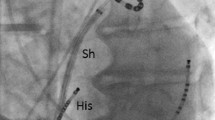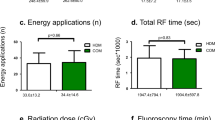Abstract
Purpose
Pulmonary vein antrum isolation (PVAI) guided by intracardiac echocardiography and a roaming circular mapping catheter is an effective treatment modality for atrial fibrillation. Unfortunately, the complexity of this technique leads to long procedure times and high fluoroscopy exposure. This study examined the effect of two different mapping systems on the procedural characteristics and clinical outcomes of PVAI for atrial fibrillation.
Methods
Referred patients underwent PVAI using a magnetic-based 3-dimensional (3-D) mapping (CARTO® System; group 1), a current-based system (EnSite NavX™; group 2), or fluoroscopy without 3-D mapping (group 3) between February 2004 and November 2009.
Results
Data were analyzed from 71 patients in group 1, 165 patients in group 2, and 197 patients in group 3. Baseline characteristics and measured long-term outcomes did not differ between the groups. Although patients in group 1 were more likely to undergo a concurrent flutter ablation (P = 0.01), they had significantly shorter procedure time, fluoroscopy time, and radiofrequency energy delivery time compared with group 2 and 3 patients. No difference was detected among the groups with respect to recurrence, mean time to recurrence, or number of PVAI procedures.
Conclusions
Use of a magnetic-based 3-D mapping system, which allows precise spatial localization of the ablation catheter, was associated with significantly lower procedure time, fluoroscopy duration, and radiofrequency energy delivery time during catheter ablation for atrial fibrillation compared with a current-based system and ablation performed without 3-D mapping, although measured short- and long-term clinical outcomes were similar.



Similar content being viewed by others
References
Camm, A. J., & Obel, O. A. (1996). Epidemiology and mechanism of atrial fibrillation and atrial flutter. The American Journal of Cardiology, 78(8A), 3–11.
Benjamin, E. J., Wolf, P. A., D’Agostino, R. B., Silbershatz, H., Kannel, W. B., & Levy, D. (1998). Impact of atrial fibrillation on the risk of death: the Framingham Heart Study. Circulation, 98(10), 946–952.
Wolf, P. A., Mitchell, J. B., Baker, C. S., Kannel, W. B., & D’Agostino, R. B. (1998). Impact of atrial fibrillation on mortality, stroke, and medical costs. Archives of Internal Medicine, 158(3), 229–234.
Connolly, S. J. (1999). Preventing stroke in atrial fibrillation: why are so many eligible patients not receiving anticoagulant therapy? CMAJ: Canadian Medical Association Journal, 161(5), 533–534.
Crandall, M. A., Bradley, D. J., Packer, D. L., & Asirvatham, S. J. (2009). Contemporary management of atrial fibrillation: update on anticoagulation and invasive management strategies. Mayo Clinic Proceedings, 84(7), 643–662.
Chung, M. K., Shemanski, L., Sherman, D. G., Greene, H. L., Hogan, D. B., Kellen, J. C., et al. (2005). Functional status in rate- versus rhythm-control strategies for atrial fibrillation: results of the Atrial Fibrillation Follow-Up Investigation of Rhythm Management (AFFIRM) Functional Status Substudy. Journal of the American College of Cardiology, 46(10), 1891–1899.
Corley, S. D., Epstein, A. E., DiMarco, J. P., Domanski, M. J., Geller, N., Greene, H. L., et al. (2004). Relationships between sinus rhythm, treatment, and survival in the Atrial Fibrillation Follow-Up Investigation of Rhythm Management (AFFIRM) Study. Circulation, 109(12), 1509–1513.
Guglin, M., Chen, R., & Curtis, A. B. (2010). Sinus rhythm is associated with fewer heart failure symptoms: insights from the AFFIRM trial. Heart Rhythm, 7(5), 596–601.
Chen, S. A., Hsieh, M. H., Tai, C. T., Tsai, C. F., Prakash, V. S., Yu, W. C., et al. (1999). Initiation of atrial fibrillation by ectopic beats originating from the pulmonary veins: electrophysiological characteristics, pharmacological responses, and effects of radiofrequency ablation. Circulation, 100(18), 1879–1886.
Haissaguerre, M., Jais, P., Shah, D. C., Takahashi, A., Hocini, M., Quiniou, G., et al. (1998). Spontaneous initiation of atrial fibrillation by ectopic beats originating in the pulmonary veins. The New England Journal of Medicine, 339(10), 659–666.
Haissaguerre, M., Shah, D. C., Jais, P., Hocini, M., Yamane, T., Deisenhofer, I., et al. (2000). Electrophysiological breakthroughs from the left atrium to the pulmonary veins. Circulation, 102(20), 2463–2465.
Natale, A., Pisano, E., Shewchik, J., Bash, D., Fanelli, R., Potenza, D., et al. (2000). First human experience with pulmonary vein isolation using a through-the-balloon circumferential ultrasound ablation system for recurrent atrial fibrillation. Circulation, 102(16), 1879–1882.
Pappone, C., Oreto, G., Lamberti, F., Vicedomini, G., Loricchio, M. L., Shpun, S., et al. (1999). Catheter ablation of paroxysmal atrial fibrillation using a 3D mapping system. Circulation, 100(11), 1203–1208.
Pappone, C., Oreto, G., Rosanio, S., Vicedomini, G., Tocchi, M., Gugliotta, F., et al. (2001). Atrial electroanatomic remodeling after circumferential radiofrequency pulmonary vein ablation: efficacy of an anatomic approach in a large cohort of patients with atrial fibrillation. Circulation, 104(21), 2539–2544.
Pappone, C., Rosanio, S., Oreto, G., Tocchi, M., Gugliotta, F., Vicedomini, G., et al. (2000). Circumferential radiofrequency ablation of pulmonary vein ostia: a new anatomic approach for curing atrial fibrillation. Circulation, 102(21), 2619–2628.
Marrouche, N. F., Dresing, T., Cole, C., Bash, D., Saad, E., Balaban, K., et al. (2002). Circular mapping and ablation of the pulmonary vein for treatment of atrial fibrillation: impact of different catheter technologies. Journal of the American College of Cardiology, 40(3), 464–474.
Estner, H. L., Deisenhofer, I., Luik, A., Ndrepepa, G., von Bary, C., Zrenner, B., et al. (2006). Electrical isolation of pulmonary veins in patients with atrial fibrillation: reduction of fluoroscopy exposure and procedure duration by the use of a non-fluoroscopic navigation system (NavX). Europace, 8(8), 583–587.
Lakkireddy, D., Nadzam, G., Verma, A., Prasad, S., Ryschon, K., Di Biase, L., et al. (2009). Impact of a comprehensive safety program on radiation exposure during catheter ablation of atrial fibrillation: a prospective study. Journal of Interventional Cardiac Electrophysiology, 24(2), 105–112.
Rotter, M., Takahashi, Y., Sanders, P., Haissaguerre, M., Jais, P., Hsu, L. F., et al. (2005). Reduction of fluoroscopy exposure and procedure duration during ablation of atrial fibrillation using a novel anatomical navigation system. European Heart Journal, 26(14), 1415–1421.
Wagner, L. K., Eifel, P. J., & Geise, R. A. (1994). Potential biological effects following high X-ray dose interventional procedures. Journal of Vascular and Interventional Radiology, 5(1), 71–84.
Lo, L. W., & Chen, S. A. (2009). Developments and recent advances in catheter ablation of paroxysmal atrial fibrillation. Future Cardiology, 5(6), 557–565.
Knackstedt, C., Schauerte, P., & Kirchhof, P. (2008). Electro-anatomic mapping systems in arrhythmias. Europace, 10(Suppl 3), iii28–34.
Piorkowski, C., Hindricks, G., Schreiber, D., Tanner, H., Weise, W., Koch, A., et al. (2006). Electroanatomic reconstruction of the left atrium, pulmonary veins, and esophagus compared with the “true anatomy” on multislice computed tomography in patients undergoing catheter ablation of atrial fibrillation. Heart Rhythm, 3(3), 317–327.
Shpun, S., Gepstein, L., Hayam, G., & Ben-Haim, S. A. (1997). Guidance of radiofrequency endocardial ablation with real-time three-dimensional magnetic navigation system. Circulation, 96(6), 2016–2021.
Juneja, R. (2009). Radiofrequency ablation for cardiac tachyarrhythmia: principles and utility of 3D ampping systems. Current Science, 97(3), 416–424.
Packer, D. L. (2005). Three-dimensional mapping in interventional electrophysiology: techniques and technology. Journal of Cardiovascular Electrophysiology, 16(10), 1110–1116.
Nademanee, K., McKenzie, J., Kosar, E., Schwab, M., Sunsaneewitayakul, B., Vasavakul, T., et al. (2004). A new approach for catheter ablation of atrial fibrillation: mapping of the electrophysiologic substrate. Journal of the American College of Cardiology, 43(11), 2044–2053.
Khaykin, Y., Skanes, A., Champagne, J., Themistoclakis, S., Gula, L., Rossillo, A., et al. (2009). A randomized controlled trial of the efficacy and safety of electroanatomic circumferential pulmonary vein ablation supplemented by ablation of complex fractionated atrial electrograms versus potential-guided pulmonary vein antrum isolation guided by intracardiac ultrasound. Circulation: Arrhythmia and Electrophysiology, 2(5), 481–487.
Faulkner, K., & Werduch, A. (2008). An estimate of the collective dose to the European population from cardiac X-ray procedures. The British Journal of Radiology, 81(972), 955–962.
Georges, J. L., Livarek, B., Gibault-Genty, G., Aziza, J. P., Hautecoeur, J. L., Soleille, H., et al. (2009). Reduction of radiation delivered to patients undergoing invasive coronary procedures. Effect of a programme for dose reduction based on radiation-protection training. Archives of Cardiovascular Disease, 102(12), 821–827.
Steven, D., Servatius, H., Rostock, T., Hoffmann, B., Drewitz, I., Mullerleile, K., et al. (2010). Reduced fluoroscopy during atrial fibrillation ablation: benefits of robotic guided navigation. Journal of Cardiovascular Electrophysiology, 21(1), 6–12.
Khaykin, Y., Mendez, C., Whaley, B., Giewercer, D., Cashabeck, D., Monaghan, J., et al. Fluoroscopy time alone is insufficient to estimate deleivered radiation dose during ablation procedures. Presented at: Heart Rhythm Society’s 31st Annual Scientific Sessions. May 12–15, 2010. Denver, Colorado. Abstract PO1-35.
Ferguson, J. D., Helms, A., Mangrum, J. M., Mahapatra, S., Mason, P., Bilchick, K., et al. (2009). Catheter ablation of atrial fibrillation without fluoroscopy using intracardiac echocardiography and electroanatomic mapping. Circulation: Arrhythmia and Electrophysiology, 2(6), 611–619.
Verma, A., Mantovan, R., Macle, L., De Martino, G., Chen, J., Morillo, C. A., et al. (2010). Substrate and Trigger Ablation for Reduction of Atrial Fibrillation (STAR AF): a randomized, multicentre, international trial. European Heart Journal, 31(11), 1344–1356.
Di Biase, L., Wang, Y., Horton, R., Gallinghouse, G. J., Mohanty, P., Sanchez, J., et al. (2009). Ablation of atrial fibrillation utilizing robotic catheter navigation in comparison to manual navigation and ablation: single-center experience. Journal of Cardiovascular Electrophysiology, 20(12), 1328–1335.
Elayi, C. S., Di Biase, L., Barrett, C., Ching, C. K., al Aly, M., Lucciola, M., et al. (2010). Atrial fibrillation termination as a procedural endpoint during ablation in long-standing persistent atrial fibrillation. Heart Rhythm, 7(9), 1216–1223.
Acknowledgments
Financial support for medical editorial assistance was provided by Biosense Webster, Inc. We thank Tamalette Loh, PhD, ProEd Communications, Inc., for her medical editorial assistance with this manuscript.
Disclosures
Drs. Khaykin and Verma have received speaker’s honoraria from Biosense Webster, St. Jude Medical; and Medtronic. Biosense Webster, Inc. provided support for medical editorial assistance for preparation of this manuscript.
Author information
Authors and Affiliations
Corresponding author
Rights and permissions
About this article
Cite this article
Khaykin, Y., Oosthuizen, R., Zarnett, L. et al. CARTO-guided vs. NavX-guided pulmonary vein antrum isolation and pulmonary vein antrum isolation performed without 3-D mapping: effect of the 3-D mapping system on procedure duration and fluoroscopy time. J Interv Card Electrophysiol 30, 233–240 (2011). https://doi.org/10.1007/s10840-010-9538-9
Received:
Accepted:
Published:
Issue Date:
DOI: https://doi.org/10.1007/s10840-010-9538-9




